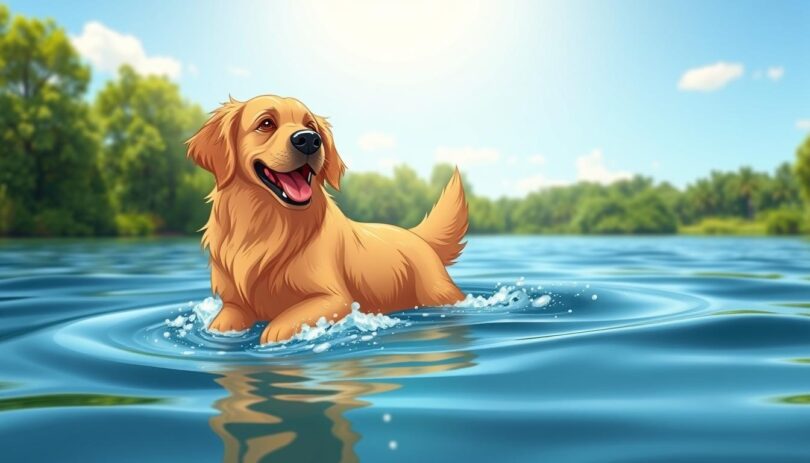Is your backyard pool creating hidden risks for your four-legged companion? While many owners assume pets share human temperature tolerances, canine biology reveals surprising differences in aquatic safety.
Healthy adult canines maintain body heat between 99.5°F and 102.5°F – significantly warmer than human averages. This biological advantage allows many breeds to enjoy cooler aquatic environments that might chill their owners. Physical activity during water play further elevates their natural warmth through increased metabolic output.
Veterinary professionals advise combining air and water measurements when assessing safety. The recommended minimum total of 100°F helps prevent hypothermia risks. However, individual factors like coat density, age, and health history dramatically influence each animal’s limits.
This guide examines breed-specific adaptations, essential safety gear, and environmental monitoring techniques. Discover how to recognize early signs of temperature stress and create optimal swimming conditions tailored to your pet’s unique needs.
Understanding Dog Physiology and Water Environments
Canine companions have unique biological systems that make their interaction with aquatic settings both fascinating and complex. Their ability to thrive in varied conditions stems from specialized heat management mechanisms developed through evolution.
How They Generate and Regulate Body Heat
Active pups produce warmth through muscle contractions during play and exercise. This metabolic process keeps their internal furnace running hotter than humans – typically between 99.5°F and 102.5°F. Unlike people who sweat extensively, furry friends primarily cool through rapid breathing and minimal paw pad perspiration.
Environmental Impacts on Canine Wellness
Air currents and liquid chill work together to influence safety. Breezy conditions accelerate heat loss from wet fur, while chilly pools draw warmth from core areas. The combination creates unique challenges during aquatic activities.
Shorter-coated breeds and senior animals often need closer monitoring. Vigorous paddling generates temporary warmth but can’t compensate for extended exposure to cold elements. Responsible owners consider both atmospheric conditions and individual pet characteristics when planning water-based recreation.
Guidelines for what temperatur can dogs swim at
Canine companions display remarkable diversity in their ability to handle aquatic environments. Their genetic heritage and physical attributes create distinct thermal thresholds that responsible owners must consider.
Optimal Water Temperatures for Different Breeds
Retrievers and water-working breeds thrive in cooler conditions. Labrador Retrievers and Portuguese Water Dogs possess oily, double-layered coats that repel moisture and trap warmth. These athletic animals often enjoy temperatures as low as 50°F when actively swimming.
Arctic-adapted breeds like Siberian Huskies carry dense undercoats that insulate against chilly waters. Their natural protection allows safe swimming in 55-60°F ranges. Conversely, short-haired varieties such as Greyhounds or Boxers require warmer environments above 70°F to prevent rapid heat loss.
Compact breeds face unique challenges regardless of fur type. Their smaller body mass cools faster, making heated pools preferable. Flat-faced companions like Bulldogs need extra supervision due to compromised breathing affecting temperature regulation.
Proper winter coats significantly impact cold-water tolerance. Thick fur acts as natural insulation, while thin layers offer minimal protection. Owners should consult breed standards and consider proper winter coats for added safety in cooler conditions.
Veterinarians recommend tailoring swim sessions to individual health profiles. Active adult dogs with good fat reserves handle colder exposures better than seniors or puppies. Regular conditioning builds endurance while maintaining safe thermal boundaries.
Best Practices for Managing Cold and Warm Weather Swimming
Seasonal shifts demand strategic planning for pet water activities. Balancing safety with enjoyment requires understanding how temperature extremes affect aquatic recreation. Tailoring approaches to weather patterns ensures every splash remains safe and fun.
Adjusting Swim Time for Safety
Cold water exposure needs strict time management. Professional trainers limit sessions to 10-20 minutes when temperatures drop below 60°F. Spring’s warm air often hides dangerously chilly lakes – 75°F days might pair with 40°F water.
Monitor weather reports for recent cold snaps affecting aquatic environments. Facilities enforce shorter play periods during cooler months, aligning with veterinary recommendations. Always ensure outdoor air stays above 45°F before allowing entry.
Comparing Cold Water vs. Warm Water Scenarios
Summer brings extended sessions but introduces dehydration risks. Provide shaded rest areas and fresh drinking water every 15 minutes. Avoid midday heat when surfaces and liquids reach unsafe degrees.
Post-swim care differs dramatically between seasons. Cold weather exits require immediate towel drying and indoor recovery spaces. Warm weather protocols focus on cooling strategies and paw protection from hot surfaces.
Essential Safety Equipment and Dog Swimming Lessons
Proper gear transforms water adventures from risky to rewarding for canine companions. Strategic equipment choices paired with gradual training create positive aquatic experiences while addressing natural hesitations many animals initially display.
Selecting Flotation Solutions
Full-coverage life jackets excel in open water environments like lakes or oceans, providing buoyancy and high-visibility colors. These rugged designs support breeds learning aquatic skills or navigating currents. For controlled pool environments, streamlined vests offer freedom of movement while maintaining critical safety features.
Secure fit proves essential – measure chest girth and neck circumference for proper sizing. Adjustable straps prevent slippage without restricting breathing. Reflective strips enhance visibility during low-light conditions, an often-overlooked safety element.
Developing Aquatic Skills
Initial training focuses on creating positive associations. Use floating toys in shallow areas where paws touch bottom, letting curious pups explore at their pace. Treat rewards reinforce voluntary entries, building trust in liquid environments.
New swimmers often paddle frantically with front legs while hindquarters sink. Quality flotation devices correct this imbalance, allowing natural four-limb coordination to emerge. Transition to deeper areas only when basic strokes develop.
Pool sessions offer predictable conditions for beginners, while beaches provide gentle depth transitions for intermediate learners. For comprehensive pet care tips and advice, consult certified trainers about tailored water acclimation programs matching your companion’s unique needs.
Monitoring Health: Recognizing Signs of Hypothermia and Overexertion
Vigilant observation during water activities prevents life-threatening complications. Early detection of temperature-related stress separates enjoyable swims from emergency situations.
Identifying Shivering, Lethargy, and Other Warning Signs
Mild hypothermia (90-99°F) triggers intense shivering as the body fights to generate heat. Watch for muscle stiffness and delayed responses to commands. These initial signs demand immediate drying and warm shelter.
Moderate cases (82-90°F) reveal critical changes. Lethargy replaces normal enthusiasm, with possible stumbling or confusion. Pale gums and shallow breathing indicate circulatory strain. At this stage, wrap your pet in heated blankets and contact a veterinarian.
Severe hypothermia (body fat reserves and faster heat loss through their compact frames.
Senior animals and those with heart conditions struggle most with temperature regulation. Monitor breathing patterns and energy levels closely. If symptoms persist after warming measures, professional assessment becomes essential for preventing organ damage.
Final Reflections on Safe Swimming Practices for Dogs
Creating safe aquatic experiences requires understanding both environmental factors and individual needs. Constant supervision remains critical near pools or natural bodies of water, as unexpected currents or submerged hazards can challenge even skilled swimmers. Always position shaded areas and fresh drinking stations near play zones to combat summer heat.
Light-coated and hairless breeds benefit from pet-safe sunscreen applied to vulnerable areas like noses and ear tips. For companions hesitant about deep-water activities, shallow wading pools with non-slip mats offer refreshing alternatives. Sprinkler games or shoreline exploration provide stimulating options that respect personal preferences.
Regularly inspect aquatic environments for changing conditions – from algae blooms to sudden temperature drops. Pair quality flotation gear with gradual skill development to build confidence. Remember that joyful interactions matter more than swimming prowess, with safety always guiding decisions.
By combining vigilance with adaptable approaches, owners foster positive relationships between pets and water. These strategies ensure every splash-filled day strengthens bonds while prioritizing health and comfort across seasons.
FAQ
How do air and water conditions affect a dog’s ability to swim safely?
Air temperature and water conditions directly impact safety. Cold weather increases hypothermia risks, while warm weather may lead to overheating. Breeds with thick coats or low body fat require closer monitoring in extreme temperatures.
What water temperatures are safest for small breeds versus large breeds?
Small dogs and short-coated breeds like Chihuahuas thrive in water above 70°F, while larger breeds such as Labradors can handle cooler temps around 60°F. Always limit swim time in cold water to prevent health issues.
Can puppies swim in the same conditions as adult dogs?
Puppies have less body fat and endurance, making them prone to hypothermia. Stick to shallow, warm water (75°F+) for short sessions. Use life jackets to build confidence and ensure safety during early swimming lessons.










Leave a Comment